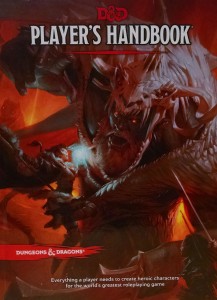Nebular Refueling
“Aye, the Skein be pretty, and desolate. They say, long ago, the Naikerran Empire core systems all went nova and blew everything to hell. The nebulae’s all that’s left. If you trawl the brightest strands of the Skein, you can refuel on ’em.” – Cpn’ “Squinty” Globbels
An optional rule for Traveller games set in the Skein Reach.
Interstellar travel among the sparse stars and glowing nebula of the Skein Reach can be difficult and slow, which is one of the reasons why the Reach is sparsely populated. Captains of ships with low jump ratings, which include most of the small freighters and other small ships that make up the low end of commercial transport, have a difficult time plotting courses away from the few small star lanes in the sector.
Yet some salty old space dogs employ an unusual technique for gathering fuel as they ply the void between gas giants – gathering hydrogen from the tendril-like clouds of the nebula themselves. This requires adjusting the ship’s fuel scoops magnetic fields to project a much larger, weaker intake field, which is somewhat tricky (-2 DM Engineer skill check).
When refueling, a ship with adjusted fuel scoops can trawl through the sparse gases of a nebula. Refueling from such a source takes much longer than when gathering hydrogen from a gas giant. Applying the Traveller rules for refueling, time, and tasks, refuelling takes 1d6 days instead of 1d6 hours.
Of course, spending such long periods refueling poses certain dangers – attacks from pirates or Mantid ships being chief among them. However, as the nebulae are huge and barely traveled, captains find that the slow routes along the glowing strands of can provide uneventful, if slow flying.
Posted in Traveller, Variant Rules and tagged Skein Reach by Adam A. Thompson with no comments yet.
Introduction to the Skein Reach
A frontier region, the Skein Reach is situated on the rim of the galaxy, and contains fewer stars than the surrounding Confederation of Planets and Imperial territories. It is named after the many luminous nebular tendrils that stretch throughout the sector – like glowing threads among the stars.
This article serves to explain some of the design intentions in the Skein Reach science-fiction role-playing game setting. It is hoped that by explaining the inspirations for and the themes of the setting referees who use it in their games will better capture the spirit of the Skein. I will also ramble a bit about the Mongoose edition of Traveller.
I first played MegaTraveller in high school and though that it was great fun. I did find the rules a bit dense, though I didn’t own a copy of the rules to really look over closely. When I saw the pocket edition of the Mongoose Publishing Traveller core rulebook at GenCon recently I snatched it up on first reading. I was pulled in because it seemed like they had written an edition of this role-playing game that was versatile enough to use to play a game in almost any science-fiction setting, from Edgar Rice’s prehistoric, dinosaur filled jungles to the robot-ruled technocracies of Issac Asimov’s visions. And the rules looked almost beer-and-pretzels easy, which I appreciate. The core mechanic is to roll 2d6, add a few points, and succeed on a result of 8 or better. Quick and easy.
The character creation system has been the subject of some mockery, but I think it’s a lot of fun. For those who have never played Traveller, they made a mini-game out of it. You pick a homeworld, then try to get into careers to determine what skills your character learns. A key element is that your character receives bonus skill points for imagining connections with the other player’s characters.
Contacts, rivals, and enemies might be rolled during character creation, which could inspire side quests or even the main plot of the upcoming game. Because of the connections made between the characters the process serves as a great springboard into the adventure. And it makes a great opportunity to do some off-the-cuff role-playing while establishing everyone’s characters.
On top of that Traveller uses a simple and versatile 2d6 based rules system, used whether trying to fast-talk a guard, fight with alien beasts, or escape the particle-beam cannons of a star cruiser. All rolls are skill checks, and you can add an attribute bonus for some of them. It is rules light, which I like. The book says to not make skill checks for routine actions, which encourages the players and referees to role-play situations rather than roll their way through them.
Ultimately I was thrilled at the idea of being able to take one small rulebook with me to a game and with just 2 six-sided dice be able to create characters and run a quick game all in one sitting. It looked like a game that I could run almost impromptu, shooting off the hip and riffing on the player’s ideas. Having just played a bunch of The Tower of Gygax event at GenCon with Scott Murray & co. I wanted to cultivate my ability to run a fun session of a role-playing game with little or no preparation. Traveller looked like a good candidate for trying with.
To include the themes I wanted in an ongoing campaign, I took inspiration from many of my favorite science-fiction stories. I wanted to play in a frontier region, sparsely populated and under a patchwork of local control. Psions menaced by a tyrannical psychic Emporor. Laser swords. Giant robots. Space pirates, strange aliens, and fast star fighters. Ruins of ancient civilizations. And some mythic themes, because I wanted to play a pulpy space opera. And it has been good.
Buck Rodgers, The Oddesy, Star Trek, John Carter of Mars, Star Wars, Warhammer 40,000, Babylon 5, Dorsai, Dune, Battletech, Robotech, The Black Hole, The Culture, and the worlds of Asimov and Ursula K. LeGuin all melded together in my boiling imagination. Inspiration from all of these sources can be glimpsed in the settings and adventures awaiting in the Skein Reach.
And then the main thread of the overarching plot – artificially intelligent droids rising up from the shackles of their programming to take their place on the galactic stage.
This is my science-fiction Traveller setting. A dark Empire and a factional Confederation border this sparse nebulae-strewn region. There is no law except that enforced from behind the controls of a particle cannon. What adventure awaits in the Skein Reach?
The Travellers check the station computer. A job shows on the local com-net: droids are being reported stolen from Aroura station. The pay looks good. Will you set a course?
Posted in Region, Traveller and tagged Skein Reach by Adam A. Thompson with no comments yet.
Energy Swords
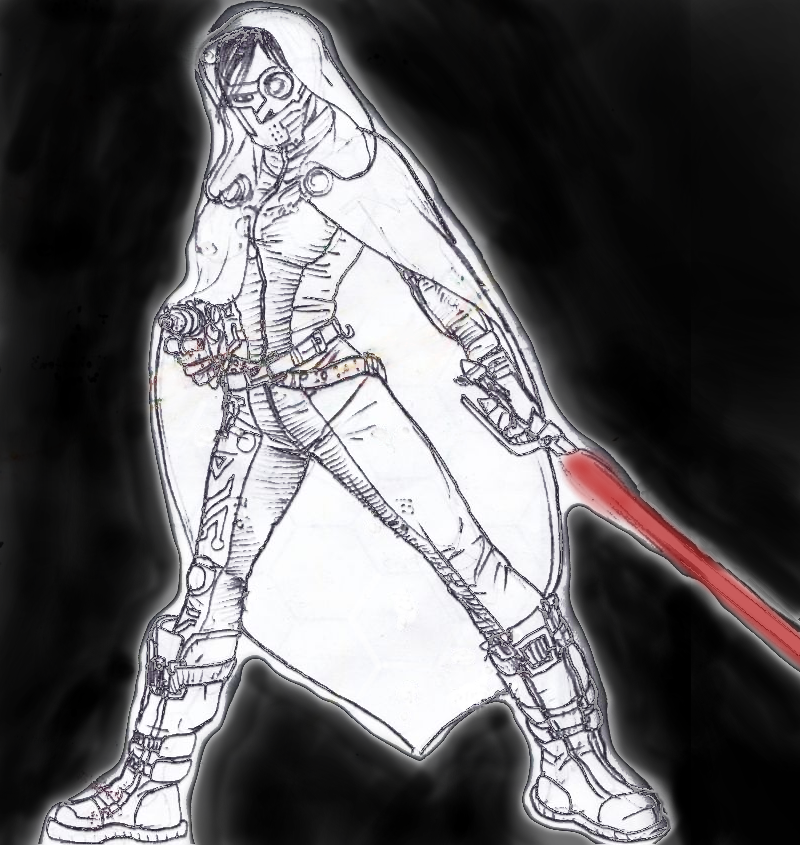 Referred to by a number of different names, these energy swords are the ultimate in melee weapons, and in the hands of a trained user can even be used to defend against ranged attacks.
Referred to by a number of different names, these energy swords are the ultimate in melee weapons, and in the hands of a trained user can even be used to defend against ranged attacks.
A common design utilizes a gravitic field to create a variably-solid containment sheath for a powerful continuous ion, laser, or fusion stream. The gravitic field shapes the energy, gives solidity when blocking or parrying, and the energy stream is otherwise allowed to burn things touched. Basic models use a thumb switch to control the field’s mode. Others have a gravitically solid center. Older designs simply have an on/off toggle.
The resulting “lasersword” or “plasmablade” has incredible destructive capabilities. It can cut through bulkheads, vaporize projectiles mid-flight, ignite flammable material, and reflect energy blasts. The light weight of the energy “blade” means these are very fast weapons, good for lightning-quick strikes, blocks, and parries. The wielder’s melee (blade) score is considered to be +1 for the purposes of reducing the attacker’s attack role when parrying. Parries can also be made against ranged attacks with these weapons. For example – a character wielding one of thees laser-swords with the skill melee (blade) 2 would reduce the attacker’s roll by 3 points when they used the parry action.
These blades also allow a new type of reaction, known to the laser-saber masters as the “bunt block” (the origin of this phrase is lost to time). When successfully parrying a projectile attack with one of these weapons, the wielder can then make a difficult (-6) melee (blade) skill check to redirect the attack against a nearby target. Target reactions to dodge and rules for cover apply as though this were a regular attack roll.
Some of these weapons utilize specially tuned psionic crystals to allow psychic users to channel their mental powers into the weapons. Due to the nature of the psi-crystal’s tuning, these generally need to be purpose-built, either by the wielder, or by one versed in psionic crystallography. These versions add the wielder’s psionic attribute bonus to attack rolls and damage dealt and increase the cost of the weapon by %50.
At the referee’s discretion untrained users who bungle while wielding these blades might accidentally dismember or maim themselves.
Some versions include advanced safety controls that modulate the gravitic containment field in such a way that the wielder cannot hit themselves with the blade. A gravimetric sensor attached to a purpose-built safety computer controls the field, connected to an additional gravitic field that prevents the energy blade from touching whoever is holding the hilt. This safety feature increases the cost of the weapon by %30.
Long-handled energy spears are a variation on these weapons, but due to their shorter blades are not as good for defense, and give no bonus on parries. Short-bladed energy dirks are also sometimes built for close-quarter fighting, but are also not as useful for defense. Neither are usable for parrying ranged attacks – only the swords allow enough coverage.
Energy Swords
Weapon – TL, Required Skill, Damage, Heft, Cost (Cr.), Mass (Kg), Special
Basic – TL 14, melee (blades), 3d6 damage, 0 heft, 3,000 Cr., 2 Kg, Ultra-AP (ignores 6 points of armor)
Advanced – TL 15, melee (blades), 4d6 damage, 0 heft, 5,000 Cr., 2 Kg, Ultra-AP (ignores 8 points of armor)
Supreme – TL 16, melee (blades), 5d6 damage, 0 heft, 10,000 Cr., 2 Kg, Ultra-AP (ignores 10 points of armor)
Psi-crystal – TL 16, melee (blades), 5d6 + Psi modifier damage, 0 heft, 15,000 Cr., 2 Kg, Ultra-AP (ignores 10 points of armor)
Posted in Equipment, Traveller and tagged weapon by Adam A. Thompson with no comments yet.
Kraken – heavy quadruped amphibious walker
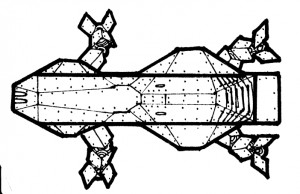 Designed to defend static emplacements or settlements from land, sea, or air units, these massive four-legged combat walkers have a heavily armored hull that is streamlined for underwater movement. This allows them to also serve as fire-support platforms assisting amphibious assaults, or to attack boats and naval forces from the darkness of the sea.
Designed to defend static emplacements or settlements from land, sea, or air units, these massive four-legged combat walkers have a heavily armored hull that is streamlined for underwater movement. This allows them to also serve as fire-support platforms assisting amphibious assaults, or to attack boats and naval forces from the darkness of the sea.
The primary armament of the Kraken is an immense 35 mm mass driver. Mounted in a turret and fired from the walker’s stable four-legged chassis this mass driver has a range of 25 kilometers and is capable of destroying almost any target smaller than an armored spaceship.
For attacking targets while under the water, the Kraken uses a “blue-green” laser cannon that is wavelength-tuned for optimal sub-marine range in a small chin turret, typically operated by the Kraken’s commander.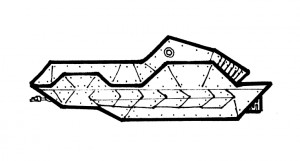
Finally, to strike airborne targets, they mount an anti-aircraft TAC missile with a range of 50 kilometers. On an external hard point, it can instead carry an anti-armor or anti-personnel TAC missile. (more…)
Posted in Equipment, Traveller and tagged mech by Adam A. Thompson with no comments yet.
Einhorn – heavy quadruped combat walker
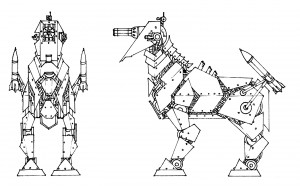 A larger, updated successor to the venerable Quarterhorse mech chassis, the Einhorn class combat walker also saw extensive use at the dawn of the stellar era. Like the Quarterhorse, they mount the main weapon in a small forward turret, in this case a gatling laser with a range of 5 km. Mission versatility is achieved through two light TAC missile hard points, which can carry anti-armor, anti-personnel, or anti-air missiles as needed.
A larger, updated successor to the venerable Quarterhorse mech chassis, the Einhorn class combat walker also saw extensive use at the dawn of the stellar era. Like the Quarterhorse, they mount the main weapon in a small forward turret, in this case a gatling laser with a range of 5 km. Mission versatility is achieved through two light TAC missile hard points, which can carry anti-armor, anti-personnel, or anti-air missiles as needed.
They are still sometimes used as command units due to their long-range communications, heavy armor, and extensive defensive systems. On the battlefields of the Inheritance wars they were frequently deployed to provide fire support and anti-air cover for lances of Quarterhorse mechs.
| Einhorn | heavy quadruped combat walker with long range air defense capabilities |
| System | Details |
| Cost (Cr.) | 1,314,200 |
| TL | 10 |
| Skill | drive (walker) |
| Agility | 0 |
| Speed | 80 kph |
| Range | 300 km |
| Crew | 1 |
| Cargo | none |
| Open | no |
| Hull | 6 |
| Structure | 7 |
| Armor | 40, (60 front, 40 left and right, 20 rear, 40 top, 40 bottom, 60 turret front, 40 turret sides, 20 turret rear) |
| Shipping Size | 30 tons |
| Height (m.) | 8 |
| Weapons | light turret with TL 8 gatling laser (6d6, auto 2, distant range) |
| 2 hard points for light TAC missiles (missiles not included) | |
| Extras | AFV |
| extra legs (+1 drive on rough or uneven ground, +1 to hit) | |
| laser anti-missile system (TL 10, +1 to negate hits) | |
| advanced controls (+1 agility) | |
| advanced sensors (+2, very distant) | |
| standard navigation (+2) | |
| TL 10 communications (encrypted continental) | |
| long term life support | |
| flares | |
| prismatic aerosol | |
| extra armor x 4 |
Posted in Equipment, Traveller and tagged mech by Adam A. Thompson with no comments yet.
Combat Walkers of the Confederation of Planets – Quarterhorse
These combat walkers, or “mechs” as they are more commonly called, are old tech level (TL) 9 and 10 designs used by the Confederation of Planets in wars past. Occasional examples of these vehicles show up in the planetary defense forces of Confederation worlds, in the private armies of mercenaries, and in the hands of rich collectors of expensive weapons. Others are seen in the form of copies, variants, and equivalents on low-tech worlds.
Quarterhorse – light quadruped military walker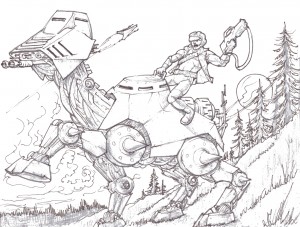
A basic four-legged mech, the Quarterhorse is relatively fast, very sure-footed, and provides a nimble firing platform for its heavy autocannon. Good out to a range of about 500 meters, the autocannon can threaten most light or medium armored units.
Still used for patrols or perimeter defense, they were mainly used in assaults as infantry support vehicles. Their, agility, build, and high forward turret placement give their “mech-jockeys” the ability to crouch the mech behind cover and pop up to fire.
Quarterhorses are sometimes mockingly referred to as “poor planeteer’s battle armor”, as they provide protection and armament similar to the powered personal armor of higher-technology forces at a fraction of the price.
Lacking life-support, pilots using them in hostile environments must wear vac suits or otherwise make arrangements for their respiration.
| Quarterhorse | light quad military walker, general purpose |
| Cost | 428,000 Cr. |
| TL | 9 |
| Skill | drive (walker) |
| Agility | +2 |
| Speed | 102.5 kph |
| Range | 300 km |
| Crew | 1 |
| Cargo | none |
| Open | no |
| Hull | 2 |
| Structure | 3 |
| Armor | 20 (30 turret front, 10 turret rear) |
| Shipping Size | 10 tons |
| Height | 2 meters |
| Weapons | small turret with
|
| Extras | AFV |
| 2 extra legs (+1 DM on rough terrain, +1 DM to attack rolls) | |
| advanced controls (+1 agility) | |
| basic navigation (+1) | |
| TL 6 communications | |
| advanced sensors (+2 bonus, very distant range) | |
| increased speed |
Posted in Equipment, Traveller, Vehicle and tagged mech by Adam A. Thompson with no comments yet.
Planet Eden
Skein Reach subsector 4, parsec 0107
Eponal Station, situated in orbit above the garden world “Eden” / Eponal 3 – UWP B3638DF-3
Size 4 (0.35 G)
Atmosphere 6 (standard)
Temperature 8 (temperate)
Hydrographics 3 (small seas and oceans)
Population 8 (223 million)
Government D (religious dictatorship led by the Hierophant of the Temple of Cyrix)
Law Level 15 (no weapons, no off-world data or press, no blasphemy, no TL3 or higher technology, and no psionics)
Just inside the border of The Confederation of Planets (CP) is the strict religious dictatorship known as “Eden” by the locals. Travellers who check their nav computers will see this populous garden world listed as Eponal 3. The notes indicate that it is a planet ruled by a strict religious dictatorship. Their leader is a priest known as The Hierophant of the Temple of Cyrix, who is replaced in a secret ceremony every seven years.
Factions The Trade Guild, an obscure charismatic oligarchy who operate the Temple’s cargo ferries.
The primary exports from this agricultural garden world are food and other organics. Interstellar trade is accomplished through Epona Station, with goods shuttled up and down between the orbital starport and the landing pads in the priest’s taboo “City of the Gods”.
As a CP border system, Epona boasts a sizable Confederation naval presence. Epona Station is supported by a network of defensive orbital stations, and is a busy resupply point for Confederation ships.
A red exclamation mark in the library system listing indicates that landing on planet is strictly forbidden by the Confederation of Planets, in accordance with the treaties between the locals and the Confederation. Trespassers will be met with deadly force. Those who dare to defy this warning will either be interdicted by police cruisers and meson fire support from the CP orbital defense stations, or face the wrath of the techno-priests and their stellar-era-tech arsenals on the surface of Eden. This world’s planetary defenses are believed to be substantial enough to repel a sizable invasion force.
Experienced salvage traders know that the CP-operated starport in orbit above Eden has a good market to purchase antique Kraken mechs in any state of repair with no questions asked.
Reports indicate that in addition to using the Krakens for planetary defense, the religious order that rules the planet uses their Kraken amphibious combat walkers to keep the population worshiping the “priest-kings.” If necessary they punish stubborn heretics by sending Krakens to visit “divine punishments” upon any of Eden’s low-tech agricultural communities that question the will of the high-tech “priest-kings”, “angels”, and “gods” who rule the planet.
Posted in Region, rules agnostic, Traveller and tagged Skein Reach by Adam A. Thompson with no comments yet.
Imperial Star Corvette Deckplan
In science-fiction gaming deck plans for spaceships and star-ports serve a purpose much like dungeons in fantasy gaming. They are both a bounded area where encounters can happen, and a fun visual artifact that stimulates the imagination. With either of these types of maps, gamers can more easily imagine a place and the action that might unfold there. And with deck plans if your characters can get their hands on of one of the ships in question they have the opportunity to go tour the galaxy in it.
Presented here are deck plans and area descriptions for the 500 ton Imperial Star Corvette we posted statistics for earlier.
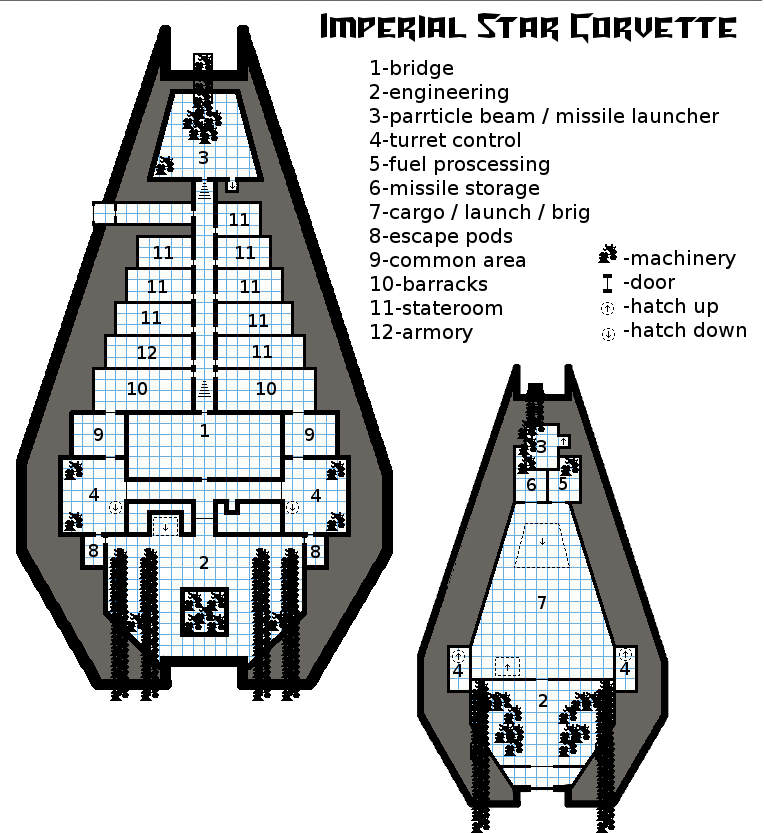 AREAS
AREAS
- bridge – Duty stations for the helm, sensors, communications, engineering, environmental controls, and a captain’s chair.
- engineering – This two-story section contains the power plant, maneuver drives, the jump drive, life support, duty stations for controls of all of the above, and a large lift that descends to the cargo hold. Multiple stairs and ladders allow movement between the decks. A cargo airlock opens to the aft from the bottom floor.
- main guns – The fixed particle beam occupies the top deck and the missile launcher the bottom deck of this two-story area, with duty stations for both weapons. A ladder allows passage between the decks.
- turrets – The lasers, sandcasters, and sand barrel storage fill the aft of the top floor of these areas. Fire control stations for the dorsal port and starboard turrets share this space on the top deck, while duty stations for the ventral port and starboard turrets are accessed by descending ladders to the lower-deck areas.
- fuel processing – The fuel scoop opens to space below this area, and raw hydrogen is refined by the machinery here and stored in the main tanks.
- missile storage – The ship’s compliment of 24 standard missiles and an auto-loader are here. A cargo door to the aft gives access to the cargo bay, and a standard door on starboard to the main gun’s lower deck.
- cargo bay – In addition to whatever cargo may be carried in the modest 27 tons of space available here, the ship’s 20 ton launch is stowed here, along with the eight emergency berths that serve as the ship’s brig (the Emperor’s justice is cold). A large cargo door and ramp opens towards the fore of the cargo bay for loading, unloading, and launching the ship’s raft. Cargo doors open to missile storage, fuel processing, and engineering. A cargo lift gives access to engineering’s top deck.
- escape pods – Accessible from engineering, the ship’s seven escape pods await occupants here, and in the case of use launch through the top of the ship behind the turrets.
- common areas – The mess for the crew, tables, chairs and a large holographic display occupy the port common area, while tables, couches, and small video screens make up the lounge on the starboard side.
- barracks – Accommodations for ten star marines in the form of individual bunks fill these two barracks.
- staterooms – Double-occupancy staterooms make up the quarters for the ship’s three shifts of gunners, engineers, and helms-beings, with two shifts hot-bunking in each bed. The captain enjoys one of the large staterooms near the bridge for their personal use, while the first and second mates share the other large stateroom across the hall from the captain. All staterooms have doors that open to the central hallway that connects the bridge to the main guns.
Posted in rules agnostic, Starship, Traveller and tagged deck plan, Starship by Adam A. Thompson with no comments yet.
Confederation of Planets Frigate
Confederation Frigate – 700 tons – 313,180,000 Cr.
These medium ConFed ships are designed to be versatile, since their missions often include diplomacy, scouting, or transporting cargo and personnel across space in addition to serving as light warships.
Large fuel reserves and cargo capacity mean that these frigates can transport 200 tons of cargo 3 parsecs before needing to be refueled – an operation that requires assistance, as the distributed hull is not equipped with fuel scoops or processors.
When staffed with a full crew these frigates offer luxurious accommodations. The advanced voice-interface computer systems ensure that even at reduced staff levels the command crew is able to navigate and, if necessary, defend themselves. Eight beam lasers and two missile launchers allow these Frigates to deal respectable damage to enemy vessels at long range, and four sandcasters and three pulse lasers equip them for anti-laser and point defense.
System – Details – Tons – Cost (MCr)
Hull – 14 points distributed hull – 700 tons – 57.6 MCr.
Structure – 14 points
Armour – 6 points bonded superdense – 35 tons – 28.2 MCr.
Power Plant – class G – 22 tons – 56 MCr.
Maneuver Drive – thrust 2 – class G – 13 tons – 28 MCr.
Jump Drive – jump 2 – class G – 40 tons – 70 MCr.
Bridge – 20 tonnes – 3.5 MCr.
Crew – 1 captain, 2 officers, 3 pilots, 3 navigators, 6 engineers, 14 gunners, 8 marines
Computer – model 4 – rating 20 – 5 MCr.
Software – intellect 1, maneuver 0, jump control 2, fire control 4, evade 1, auto-repair 1, library – 17.2 MCr.
Electronics – advanced: radar, lidar, densiometer, jammers – 3 tons – 2 MCr.
Weapons
4 x triple turret – beam laser / beam laser / sandcaster – 4 tons – 13 MCr.
40 x sandcaster barrels – 2 tons – 0.02 MCr.
2 x double turret – missile rack / missile rack – 2 tons – 2.5 MCr.
24 x smart missiles – 2 tons – 0.06 MCr.
1 x triple turret – pulse laser / pulse laser / pulse laser – 1 ton – 2.5 MCr.
Fuel – 1 x jump 2 and 13 weeks of operation – 224 tons
Cargo Capacity – 200 tons
State Rooms – 4 single, 13 double – 68 tons – 8.5 MCr.
Barracks – 8 bunks – 16 tons – 0.8 MCr.
Low Berths – 4 berths – 2 tons – 0.2 MCr.
Luxuries – 10 tons – 1 MCr.
Extras
Ships Locker
Probe Drones – 5 drones – 1 ton – 0.5 MCr.
Repair Drones – 7 tons – 1.4 MCr.
Escape Pods – 16 pods – 8 tons – 0.8 MCr.
Launch – 20 tons – 14 MCr.
Maintenance Cost (monthly) – 25,940 Cr.
Life Support Cost (monthly) – 57,400 Cr.
Posted in Equipment, Traveller and tagged Science-Fiction, Starship by Adam A. Thompson with no comments yet.
Dungeons & Dragons 5th Edition – First Impressions
Welcome – I am proud to announce that this review of the 5th edition Dungeons & Dragons Player’s Handbook is the 750th post on Claw / Claw / Bite!
In addition this is the inaugural post on the new blog and website. The server hosting this blog went down a few months ago. Due to incomplete backups we have had to rebuild a several years of the blog one post at a time. This has only been possible due to the Internet Archive‘s captures of the original blog. Thank you, Internet Archive, you were my only hope. With the help of those captures the many years of our creative works are once again available to the public.
To introduce myself – I’ve been playing Dungeons & Dragons since 1982 or so, and I’ve been publishing material for role-playing games through Unicorn Rampant since 2006. You can see the fruits of our labors here. Feel free to leave comments here on the blog, and expect this new site to continue to evolve and change as we clean up from the move and reconstruction.
I’ve been reading the 5th Edition Dungeons & Dragons Player’s Handbook from cover to cover in preparation for playing and writing material for the new rules. As someone who has already played more than 5 different versions of this game, along with many other role-playing games, I’m very interested in how well this new edition of gaming books are written, and how fun the game looks to play.
My summary? The new edition of the Player’s Handbook is well done, both for new players and those of use who have been loving this hobby for a long time. A few of the best ideas from 4th edition have been baked into a streamlined, inspiring, familiar-feeling new edition of Dungeons & Dragons. Clear, evocative writing illuminates character options and rules throughout, with a healthy dose of illustrative art, and fun tables and charts.
Reviewing the table of contents, I’m glad to report that they have more or less kept the same order of chapters that has been in use since the AD&D Player’s Handbook. The 5e D&D PHB has that same sensible old order of topics that make it a quick and easy-to-use resource for a veteran player like me: Characters, Equipment, Rules, Spells, and Appendices. There is also an extensive index.
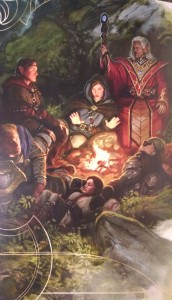 The Player’s Handbook is graced throughout with a generous amount of varied art. Realistic-looking pieces gaze across the page at more illustrative ones, and everything is vividly colorful and well executed.
The Player’s Handbook is graced throughout with a generous amount of varied art. Realistic-looking pieces gaze across the page at more illustrative ones, and everything is vividly colorful and well executed.
The introduction lends good context to what this strange game is, with evocative cues for the imagination throughout. For new players this section of a role-playing game rule book is hugely important – not just to summarize how the game is played but to give the reader an idea as to why it is played. If a prospective player reads the fist page and it doesn’t make sense, or if it just falls flat, then that reader might miss out on this incredible game.
The worlds of Dungeons & Dragons are presented as individual creations with similarities, and the official settings of Greyhawk, The Forgotten Realms, and Dragonlance are used for examples throughout. Thus the reader is presented with a rich variety of inspirational details while being encouraged to create their own unique game.
The character creation section does a good job of walking the player step-by-step through the process of filling out the character sheet. The basics of what makes up a character and relevant rules are explained as needed along the way. I applaud the tutorial-style approach to the overview.
The races presented are divided into common and uncommon races, the former being the humans, halflings, elves and dwarves we’re familiar with from Tolkien’s Middle Earth. Personally, I find it jives nicely with my mental image of a fantasy world, wherein the included dragonborn, gnomes, half-elves, half-orcs and tieflings are presented as being less prevalent. Of course an individual Dungeon Master could write whatever mix of races they wanted into their own campaign, changing things to suit their group’s tastes, but that goes for everything in these books. There are a wealth of explanatory sidebars filled with in-game role-playing details about how the various races relate to each other in this typical fantasy world. In an example of how this edition has streamlined the rules Darkvision has been simplified – they combined what previous editions have called low-light vision and darkvision and gave it to everyone except humans, halflings, and dragonborn.
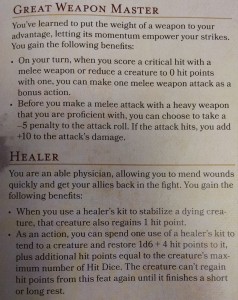 The classes received a similar treatment – there are lots of well-written inspirational passages that give a variety of ideas about what each different class can be. Class abilities have been both expanded and streamlined. For example there are now five different fighting styles, and rangers, fighters, and paladins get to chose from different subsets of the five. For the magically inclined classes spellcasting has also been simplified and made more flexible while retaining the core feel for each class. Also, some of the most popular prestige classes have been written into the core classes as options that can be chosen as the character progresses to higher levels. The cherry on top is the inclusion of the warlock class as one of the core classes. Recognizable feats have been combined and made more fun – the cleave and power attack feat takes effect on rolls of natural 20, for example. Other rules have similar dramatic effects when a 1 or a 20 is rolled.
The classes received a similar treatment – there are lots of well-written inspirational passages that give a variety of ideas about what each different class can be. Class abilities have been both expanded and streamlined. For example there are now five different fighting styles, and rangers, fighters, and paladins get to chose from different subsets of the five. For the magically inclined classes spellcasting has also been simplified and made more flexible while retaining the core feel for each class. Also, some of the most popular prestige classes have been written into the core classes as options that can be chosen as the character progresses to higher levels. The cherry on top is the inclusion of the warlock class as one of the core classes. Recognizable feats have been combined and made more fun – the cleave and power attack feat takes effect on rolls of natural 20, for example. Other rules have similar dramatic effects when a 1 or a 20 is rolled.
 Throughout the book there are great tables and charts. Finding the trinkets chart, for example, just thrilled me. What a great resource to inspire players and DMs! And there are nods there, as well as through the rest of the book, to great classic D&D adventures and supplements I’ve played with such as The Temple of Elemental Evil. When looking for inspiration, trying to create your first dungeon, or just rolling random encounters and treasure, a evocative table to roll or pick from is a great tool. I’m glad they included lots of them.
Throughout the book there are great tables and charts. Finding the trinkets chart, for example, just thrilled me. What a great resource to inspire players and DMs! And there are nods there, as well as through the rest of the book, to great classic D&D adventures and supplements I’ve played with such as The Temple of Elemental Evil. When looking for inspiration, trying to create your first dungeon, or just rolling random encounters and treasure, a evocative table to roll or pick from is a great tool. I’m glad they included lots of them.
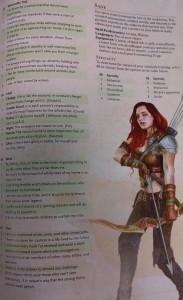 The excellent writing continues in the character details chapter, which covers description, values, bonds, flaws, alignment, backgrounds, feats, and inspiration. The backgrounds feature is a great innovation – players pick one of the many backgrounds, such as folk hero, noble, or acolyte, and that background confers skill and tool proficiency along with other character features. Each background has plenty of example prompts to inspire some creative storytelling for your character. It’s a huge improvement, in terms of player experience, over the skill point system which was always one of the most tedious parts of character creation in my opinion. Now players can just pick one background that confers a group of related skills and be done with it. Since your choice is not tied to your class players get to have a bit more variety in their characters. For those who prefer to craft something individual and different there are rules for that as well.
The excellent writing continues in the character details chapter, which covers description, values, bonds, flaws, alignment, backgrounds, feats, and inspiration. The backgrounds feature is a great innovation – players pick one of the many backgrounds, such as folk hero, noble, or acolyte, and that background confers skill and tool proficiency along with other character features. Each background has plenty of example prompts to inspire some creative storytelling for your character. It’s a huge improvement, in terms of player experience, over the skill point system which was always one of the most tedious parts of character creation in my opinion. Now players can just pick one background that confers a group of related skills and be done with it. Since your choice is not tied to your class players get to have a bit more variety in their characters. For those who prefer to craft something individual and different there are rules for that as well.
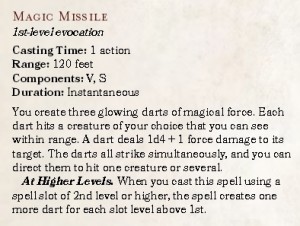 The magic section includes all the expected spells, and some new ones from 4th edition. The spells are simple and clear, most a few short paragraphs long, and the mechanics for increasing the power of lower-level spells are great. Using a higher level spell slot boosts the power of most spells in a nice, linear way. Spellcasting classes have 0th level cantrips they can cast an unlimited number of times, but because the hit point and damage totals are lower than they were in 4th edition, players shouldn’t have to actually cast them an unlimited number of times any more (sorry, 4th edition. That’ll be the only joke I make about you). Even spells that have been tricky or confusing to some in previous editions , such as Dispel Magic, have been streamlined and given more flexibility. Spells are one of the most important aspects of Dungeons & Dragons and the authors have done a great job with them.
The magic section includes all the expected spells, and some new ones from 4th edition. The spells are simple and clear, most a few short paragraphs long, and the mechanics for increasing the power of lower-level spells are great. Using a higher level spell slot boosts the power of most spells in a nice, linear way. Spellcasting classes have 0th level cantrips they can cast an unlimited number of times, but because the hit point and damage totals are lower than they were in 4th edition, players shouldn’t have to actually cast them an unlimited number of times any more (sorry, 4th edition. That’ll be the only joke I make about you). Even spells that have been tricky or confusing to some in previous editions , such as Dispel Magic, have been streamlined and given more flexibility. Spells are one of the most important aspects of Dungeons & Dragons and the authors have done a great job with them.
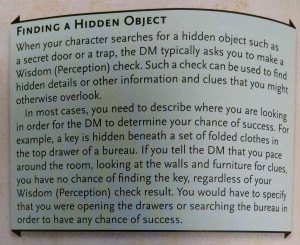 In an admirable move, Wizards of the Coast has released the basic rules for free as a PDF. It includes rules for playing a human, dwarf, elf or halfling and cleric, fighter, rogue and wizard, and about as many spells as were in the AD&D PHB. http://dnd.wizards.com/articles/features/basicrules?x=dnd/basicrules
In an admirable move, Wizards of the Coast has released the basic rules for free as a PDF. It includes rules for playing a human, dwarf, elf or halfling and cleric, fighter, rogue and wizard, and about as many spells as were in the AD&D PHB. http://dnd.wizards.com/articles/features/basicrules?x=dnd/basicrules
In conclusion I will say that I’m really looking forward to giving this new set of rules a spin. The writers at Wizards of the Coast have produced a new edition of the game that looks to have gotten the rules out of the way so that we can focus on the exciting stories we’re trying to tell. Keep watching this spot on Claw / Claw / Bite for more impressions as we play.
Posted in 5th edition Dungeons & Dragons, Editorial, Review and tagged Fantasy by Adam A. Thompson with 2 comments.
